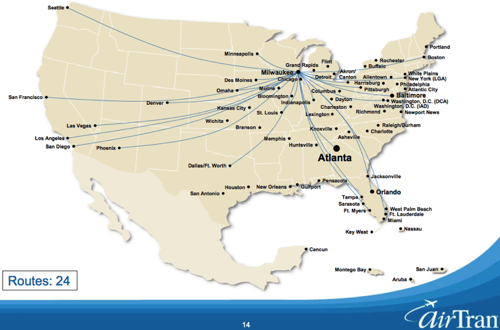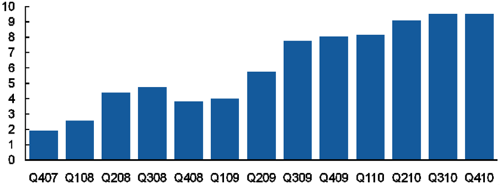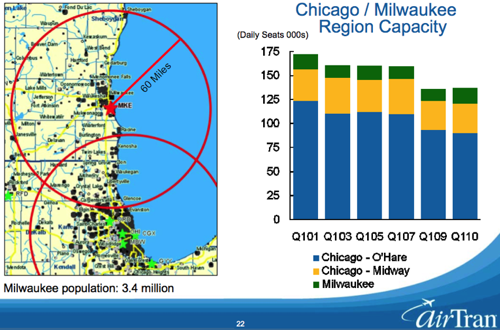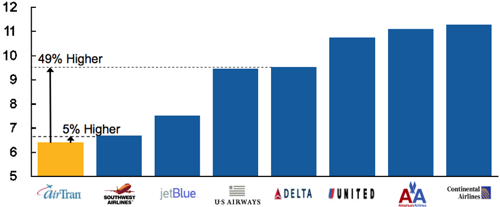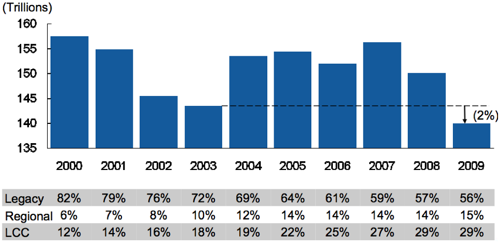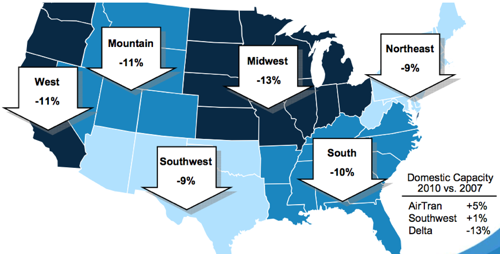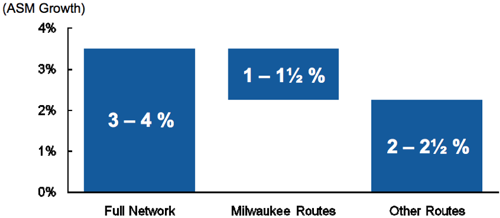AirTran outlook - and updates on the Milwaukee battleground
AirTran's presentation at the Raymond James 31st Annual Institutional Investor Conference placed two things at the forefront of investors' minds - the Milwaukee end game and international expansion. With Milwaukee (MKE) in play between three different carriers which hope to build it into Chicago's low-cost airport, AirTran CFO, Arne Haak, was just as uncertain on the future there as the rest of the industry.
One thing is clear though (as acknowledged by Republic Airways CEO, Bryan Bedford), there is only room for two carriers in the market. And, with the strength of both Southwest and AirTran, it remains unclear if Republic can hold its own as it tries to build back market share with its, as yet, confusing Frontier/Midwest double brand there. While Republic talks a good game, the end game could get messy.
The players
Southwest so far has a small presence in the market compared to AirTran and Frontier/Midwest and must be careful it does not dilute its investment in nearby Midway. But the traditional business-oriented Midwest is now being complemented by leisure focused Frontier - we think. At least that is what RJET is saying, as it figures out how it will finally merge the two brands. Look for an announcement later this month on that. Consequently, Republic's Frontier/Midwest is up against Southwest and AirTran in both the leisure and business markets.
"I think you have to ask that question to all three airlines," said Haak, in response to a question on what the ultimate outcome will be at the airport. "For our part, we are very pleased with how Milwaukee is playing out. It was profitable last year. Southwest is now in the leisure routes, but leisure is holding up well. We've shown we can compete against Southwest since we do that every day in Baltimore, so we know we can do it in the leisure markets at Milwaukee", he said.
Haak added, "we don't know what Republic's thoughts are but we do know they are putting a lot of capacity back in trying to recapture the Midwest brand. There is not a lot of public data, but they've made comments that there costs are in line with Southwest and AirTran now they are post-bankruptcy. That may be possible on their A320 fleet, but we have the lowest unit costs and when you look across our fleet, not just a couple of markets particularly in Milwaukee. We are growing into the business routes and are pleased how that is progressing. Ultimately, it is very possible that the endgame will be two airlines sharing leisure markets and two sharing the business markets. The question is what size will those airlines be and I don't have an answer to that."
In fact, Republic has said that it beats both Southwest and AirTran given the fact that its E-Jets and its own costs are lower. It is, however, counting on the fact that it saves USD3-4 million per year per shell for every B717 it replaced, as well as another USD1 million per year per shell for every SkyWest aircraft it replaced. However, while those cost comparisons are against Southwest and Delta, it has no such comparison with AirTran. See article: Republic Airways plays it closer to the chest than usual.
As for market share, it shows greater market share than AirTran as of December.
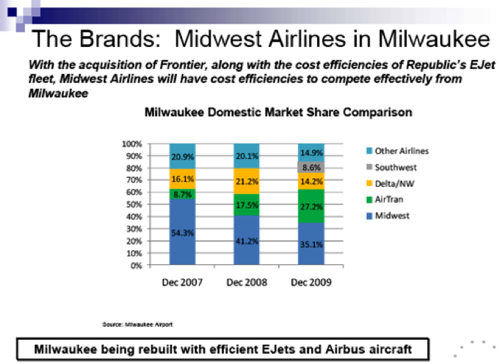
MKE to Chicagoland what BWI is to Washington
AirTran sees Milwaukee as being similar to its Baltimore operation, which is the lowest fare airport in the Washington DC metropolitan area. Like Baltimore, it also has a train-to-plane interface, making for easy, non-car access from even the Chicago Loop. The airport is also only a 45-50 minute drive from the majority of its customers from the affluent northern suburbs, about the same trip time as to O'Hare, according to the airport.
While further from Chicago than Baltimore is to Washington, Southwest and AirTran, along with General Mitchell International airport itself, are trying the make Milwaukee a viable alternative to higher cost O'Hare and Midway. Southwest, of course, must ensure it does not dilute the significant investment it has made in Midway.
"We are in 18 of the top 20 markets in Milwaukee," said Haak. "It is unfair to consider Milwaukee on its own. It has to be considered in terms of the Chicago region. It is a big city on its own and within 60 miles are over three million people. There is a lot of corporate business and it has been largely a business class market meaning higher fares. Because of that, many people drove to Chicago for leisure fares. Just as Baltimore is lower cost than other Washington airports, the same holds for Milwaukee. In addition, capacity at O'Hare is way down and Midway is basically flat. Milwaukee has grown in the first quarter, but is still way down from what it used to be."
AirTran is Now Milwaukee's Largest Mainline Carrier
AirTran Milwaukee Daily ASMs (mill)
AirTran, Midwest, Frontier and Delta all added flights to Mitchell in 2009, and with the startup of Southwest Airlines in November, the airport served 600,683 more passengers in the final four months of the year than in the same period of 2008.
Airport Director, Barry Bateman, noted number of passengers from northern Illinois and the northern Chicago suburbs taking advantage of Mitchell's low-fare service continues to grow. "For the last six months of 2009, the number of Illinois cars in our parking areas averaged over 10%," he said. "Milwaukee/Chicago is a busy region for air travel, and Mitchell International has become one of the most price-competitive airports in the nation."
The airport broke passenger number records in the final quarter of the year, thanks to the additional service laid on by Delta, Southwest, AirTran and Midwest/Frontier. Dec-2009 passenger count was the busiest on record for the month of December. The December total of 728,067 passengers was an increase of 33.91% over last December's 543,679 passengers, and was the first time more than 700,000 passengers used the airport in the month of December.
For the year, however, Mitchell's passenger total declined 0.13% from 2008's record number, as a result of flight reductions at Mitchell and airports throughout the US. Each of the last four months of the year was a record for that month, however, with enough passengers to bring the 2009 passenger count, at 7,946,562, to just a fraction off the 2008 total of 7,956,968. Nationwide, passenger traffic declined 6% in 2009 compared with 2008, according to the Air Transport Association.
It has been decades since the airport was first touted as the third Chicago airport, with little happening to make that a reality. Doubters suggest business travelers will be loathe to leave Chicago, but business travelers are already migrating to low-cost carriers across the country so it is more than likely the airport will gain some traction there. However, the advent of low-cost carriers with extensive domestic networks - something not seen before at the airport - coupled with very aggressive competition may make the difference. While some question its reliance on low-cost carriers, Baltimore has made a success of just that model with Southwest chasing out US Airways only to face competition from AirTran. Interestingly, the airport reckons about one million of its nearly 8 million passengers hail from Northern Illinois, which enjoys a rich economic base.
Milwaukee Plays Big Role in Downsized Chicago Region
With 48 markets, Mitchell International has moved up to 28th among US airports in number of markets served nonstop, according to new data published by the Brookings Institute, compared to 34th in a 2004 study. The new ranking means that more nonstop markets are served out of Milwaukee than out of other Midwestern cities, such as Nashville; Pittsburgh; Indianapolis and Columbus, and out of medium-sized cities elsewhere in the US, including Portland, OR; Austin; New Orleans; San Diego; Raleigh/Durham; Albuquerque; San Antonio and Hartford, CT.
The average airfare out of Milwaukee was lower than the average at 75 other US airports, according to the latest US Department of Transportation statistics (2nd Quarter 2009). Mitchell's average fare was about USD44 less than O'Hare's and USD28 less than the nation's average fare.
International expansion
The concentration so far has been on the Caribbean markets, said Haak in responding to a question about the potential for a Canadian incursion. He noted that the Caribbean was on its radar for several years before it took the plunge and Canada has not joined the list of potential expansion targets. "Flying to airports that are predominantly international, it is harder to get the same kind of unit costs than we do in the domestic markets," he said. "But it is something we are looking at and if there are markets that are underserved and overpriced then it could be a good opportunity for us."
Analysts are viewing the evolution of low cost carriers and noting that the next big growth potential will come from going international. After starting out as purely leisure carriers, they have all targeted the business traveler as their current target for growing their business. Thus, analysts were likely trying to get a jump on the prospects for that next growth spurt. Thus far, however, growth has been restricted to the Caribbean where JetBlue and AirTran have made significant capacity investments in the last year. JetBlue has taken it further going into South America.
Southwest, with cross border plans to both Mexico and Canada through partnerships with Volare and WestJet, indicated that expansion will now not come until 2011.
The lowest cost
"We have moved from being a low-cost carrier to being the lowest cost airline," said Haak. "If you look at our 2009 adjusted cost to our average stage length it is 738 miles - 5% lower than Southwest on non fuel operating costs and we are 50% lower than Delta and US Airways, which have benefited from bankruptcy to lower their unit costs.
Industry Cost Comparison: Non-Fuel Unit Costs at 738 Miles (US cents: 2009
"Legacies have lost about USD60 billion since 9/11, with a couple of positive years in there as they benefited from bankruptcies," he said. "This is what we are competing against and why low-cost carriers are doing so well. The Legacies have continued to shrink and shrink and shrink and they have outsourced to regionals that have lower costs than the legacies but now as low as ours. The Legacies used to have 80% of the market and are now down to 50%. The regionals have taken some of that but the low-cost carriers are now 30% of the business. Capacity reductions have come across the board. Our capacity is up 5% since 2007, Southwest is up 1% and Delta is down 13%".
Continental US capacity (ASMs, trillions): 2000-2009
The result is we now have the lowest amount of domestic capacity that we've had in a decade. In fact, it is 2% below the industry's lowest point in 2003. We may see come modest capacity growth this year but we still see a good industry backdrop for us in the amount of seats and airplanes that are no longer out there flying."
Domestic capacity changes (% change): 2010 vs 2007
AirTran capacity (ASM) growth: 2010
We expect this year we will have growth at 3-4% this year," he said. "Only about one third will be in Milwaukee and the rest will be in Florida, the Caribbean and Baltimore.
"We are one step away from being a commodity, said Haak.
Ancillary revenue reduces "hypercompetitive" initial sale: the fare
On the hot topic of ancillary revenues, Haak noted, "we've seen the unbundling of pricing similar to what you have seen in other businesses, such as hotels".
He explained, "ancillary revenues means that you are less dependent on the initial sale. The reason that is important is the initial sale - the fare - is hypercompetitive. When a passenger makes the first purchase it is usually the airfare and they spend two to three hours figuring a way to save the last USD8. After that initial purchase they tend to spend more freely. So, if you think about 'wallet share' and what has happened to airlines, the airlines' wallet share of the travel budget is declining. What is really eye opening is when you talk to travel managers. They are not so worried about domestic air travel. That is not a big concern. They are more worried about managing hotels, cars and not so much the airfare. By unbundling the pricing, it allows you to get revenue at multiple points in the journey."
